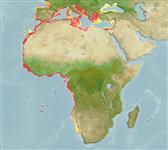Ikan bertulang rawan (sharks and rays) >
Squatiniformes (Angel sharks) >
Squatinidae (Angel sharks)
Etymology: Squatina: Latin for skate, which angel sharks superficially resemble, presumably tautonymous with Squalus squatina Linnaeus 1758 (no species mentioned). (See ETYFish); oculata: Latin for eyed or having eyes, referring to the symmetrical ocelli seen on some specimens. (See ETYFish).
More on author: Bonaparte.
Environment: milieu / climate zone / depth range / distribution range
Ekologi
laut dasar (demersal); kisaran kedalaman 5 - 500 m (Ref. 10719), usually 50 - 100 m (Ref. 247). Subtropical; 47°N - 29°S, 17°W - 37°E
Eastern Atlantic: Mediterranean and Morocco to Angola.
Size / Weight / umur
Maturity: Lm ? range ? - ? cm
Max length : 160 cm TL jantan/; (Ref. 247); common length : 120 cm TL jantan/; (Ref. )
deskripsi pendek
Morfologi | Morfometrik
Duri punggung (Keseluruhan (total)): 0; duri punggung lunak (Keseluruhan (total)): 0. An angelshark with large thorns on snout and above eyes but not on midback, weakly bifurcated nasal barbels and weakly fringed anterior nasal flaps, the first dorsal-fin origin usually well behind the rear tips of pelvic fin, and prominent white spots on body (Ref. 247)
Found on sand and mud bottom (Ref. 26999) of continental shelves and upper slopes (Ref. 247). Mostly between 50 and 100 m but deeper in the tropics (Ref. 247). Feeds on small fishes (Ref. 247). Ovoviviparous (Ref. 50449). Utilized fresh and dried salted for human consumption; liver oil and hide also used (Ref. 247).
Life cycle and mating behavior
Kematangan | Reproduksi, perkembang biakan | Pemijahan | telur-telur | Fecundity | Larva
Ovoviviparous, embryos feed solely on yolk (Ref. 50449). Size at birth about 24 to 27 cm TL (Ref. 247).
Compagno, L.J.V., 1984. FAO Species Catalogue. Vol. 4. Sharks of the world. An annotated and illustrated catalogue of shark species known to date. Part 1 - Hexanchiformes to Lamniformes. FAO Fish. Synop. 125(4/1):1-249. Rome, FAO. (Ref. 247)
Status IUCN Red List (Ref. 130435)
ancaman kepada manusia
Traumatogenic
penggunaan manusia
Perikanan: nilai komersial kecil
informasi lanjut
Umur / SaizPertumbuhanpanjang-beratpanjang-panjangukuran frekuensiMorfometrikMorfologiLarvaDinamika larvapemulihanKelimpahanBRUVS
AcuanBudidaya airprofil budidaya airStrainGenetikaElectrophoresesDiturunkanPenyakit-penyakitPengolahanNutrientsMass conversion
mitraGambarStamps, Coins Misc.Suara-suaraCiguateraKecepatanTipe renangArea insangOtolithsOtakPenglihatan / visi
Alat, peralatan
laporan khas
muat turun XML
Sumber internet
Estimates based on models
Preferred temperature (Ref.
123201): 13 - 19.3, mean 15.3 °C (based on 133 cells).
Phylogenetic diversity index (Ref.
82804): PD
50 = 0.5000 [Uniqueness, from 0.5 = low to 2.0 = high].
Bayesian length-weight: a=0.00550 (0.00303 - 0.00997), b=3.06 (2.90 - 3.22), in cm total length, based on LWR estimates for this species & Genus-body shape (Ref.
93245).
Trophic level (Ref.
69278): 4.0 ±0.5 se; based on diet studies.
Daya lenting (Ref.
120179): Rendah, Waktu penggandaan populasi minimum 4.5 - 14 tahun (Fec assumed to be <100).
Fishing Vulnerability (Ref.
59153): Very high vulnerability (90 of 100).
Nutrients (Ref.
124155): Calcium = 16.4 [3.7, 79.5] mg/100g; Iron = 0.706 [0.185, 2.111] mg/100g; Protein = 19.2 [17.1, 21.1] %; Omega3 = 0.237 [0.112, 0.507] g/100g; Selenium = 36 [11, 102] μg/100g; VitaminA = 9.75 [3.35, 29.81] μg/100g; Zinc = 0.442 [0.216, 0.817] mg/100g (wet weight);
